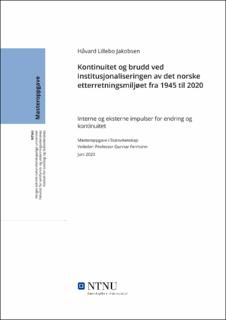| dc.contributor.advisor | Fermann, Gunnar | |
| dc.contributor.author | Jakobsen, Håvard Lillebo | |
| dc.date.accessioned | 2021-09-28T17:32:46Z | |
| dc.date.available | 2021-09-28T17:32:46Z | |
| dc.date.issued | 2020 | |
| dc.identifier | no.ntnu:inspera:54524029:21358267 | |
| dc.identifier.uri | https://hdl.handle.net/11250/2784518 | |
| dc.description.abstract | Ved hjelp av within-case-metode undersøker jeg institusjonaliseringen av det norske etterretningsmiljøet fra 1945 og frem til i dag. Jeg undersøker hvilke eksterne og interne impulser som gjør seg særlig gjeldende i påvirkningen av den sosiale strukturen, det sosiale innholdet, og det materielle innholdet i etterretningsmiljøet. I analysen anvender jeg en pragmatisk innrettet analysemodell, inspirert av teori innen offentlig politikk og administrasjon (OPA), utenrikspolitisk analyse (UPA), etterretningsfag, og institusjonell endring. Analysen byr på en rekke innsikter som angår etterretningsmiljøets utvikling. Det overordnede bildet tyder på at etterretningsmiljøets utvikling primært er formet av sterke eksterne impulser og at interne impulser først blir særlig framtredende i fraværet av sterke eksterne impulser, eller i møte med særskilte nasjonale utfordringer. For det norske etterretningsmiljøets del var trusselen fra Sovjetunionen en sterk påvirkningskraft gjennom hele den kalde krigen. Denne trusselen var bakteppet for den betydelige amerikanske interessen og investeringsviljen i norsk etterretning. Den kalde krigens slutt var et strategisk sjokk for etterretningsorganene, medførte betydelige reformatoriske endringer. E-tjenesten og PST slik vi kjenner dem i dag bedre samordnet enn noen gang før, og er med dette muligens på vei til å skape et reelt enhetlig norsk etterretningsmiljø. | |
| dc.description.abstract | By utilizing within-case methods, I examine the institutionalization of the Norwegian intelligence community from 1945 and up until today. I examine which external and internal impulses that have a significant impact on the influence of the social structure, social content, and material content of the intelligence community. In the analysis I apply a pragmatically arranged research model inspired by theories of public policy and administration, foreig policy analysis, intelligence, and institutional change. The analysis offer a number of insights on the development of the intelligence community. The overarching picture suggests that the development of the intelligence community primarily is shaped by strong external impulses, and that internal impulses only manifests themselves in the absence of strong external impulses, or in the face of particular domestic challenges. For the Norwegian intelligence community, the threat of the Soviet Union was a strong influence throughout the Cold War. This threat was the background for the significant American interest and willingness to invest in Norwegian intelligence. The end of the Cold War constituted a strategic shock for the intelligence agencies, and lead to significant reformatoric alterations. The Norwegian Intelligence Service and Police Security Service as we know them to day are better coordinated than ever, and might be on the path of creating a genuine unified intelligence community. | |
| dc.language | | |
| dc.publisher | NTNU | |
| dc.title | Kontinuitet og brudd ved institusjonaliseringen av det norske etterretningsmiljøet fra 1945 til 2020 | |
| dc.type | Master thesis | |
